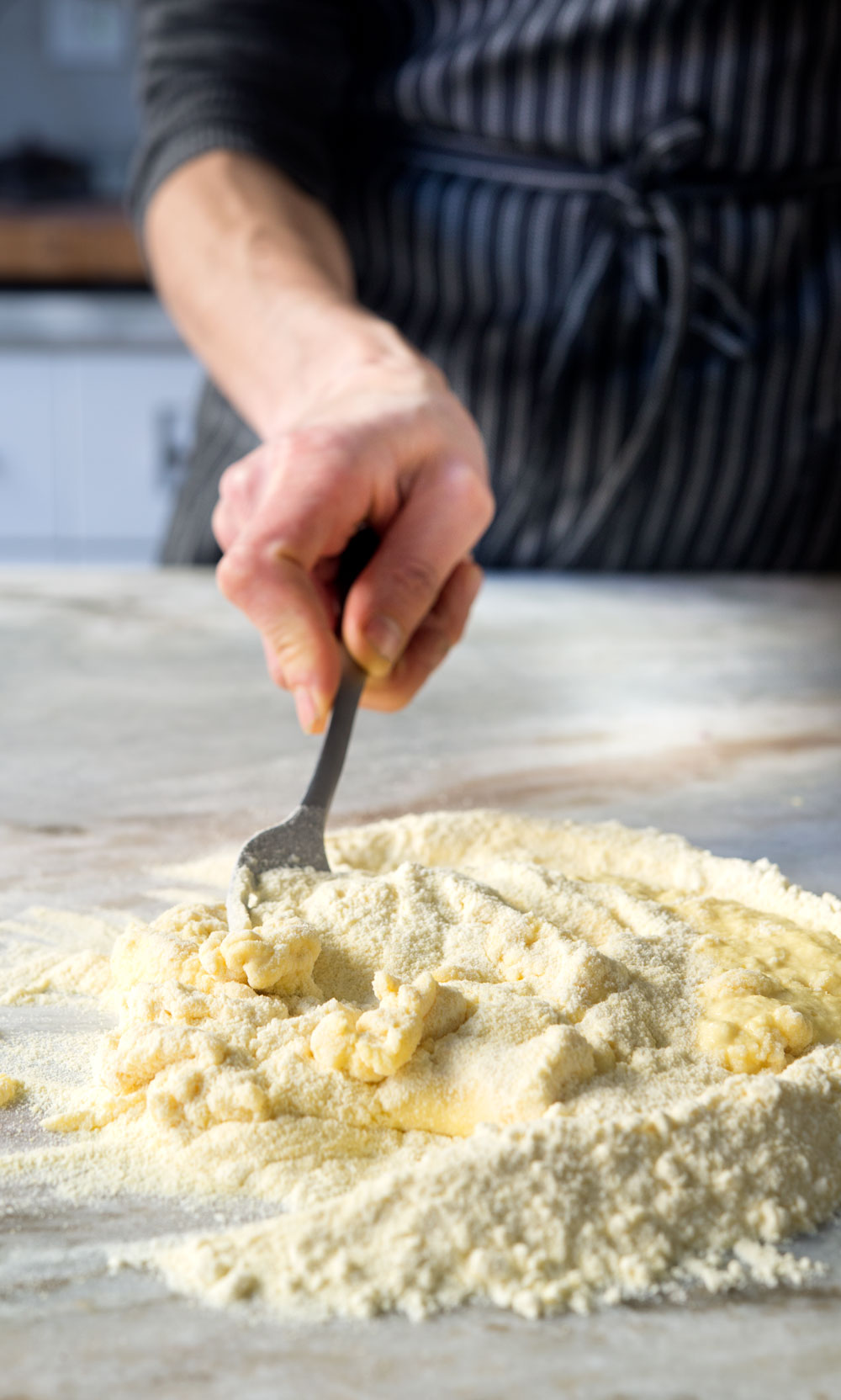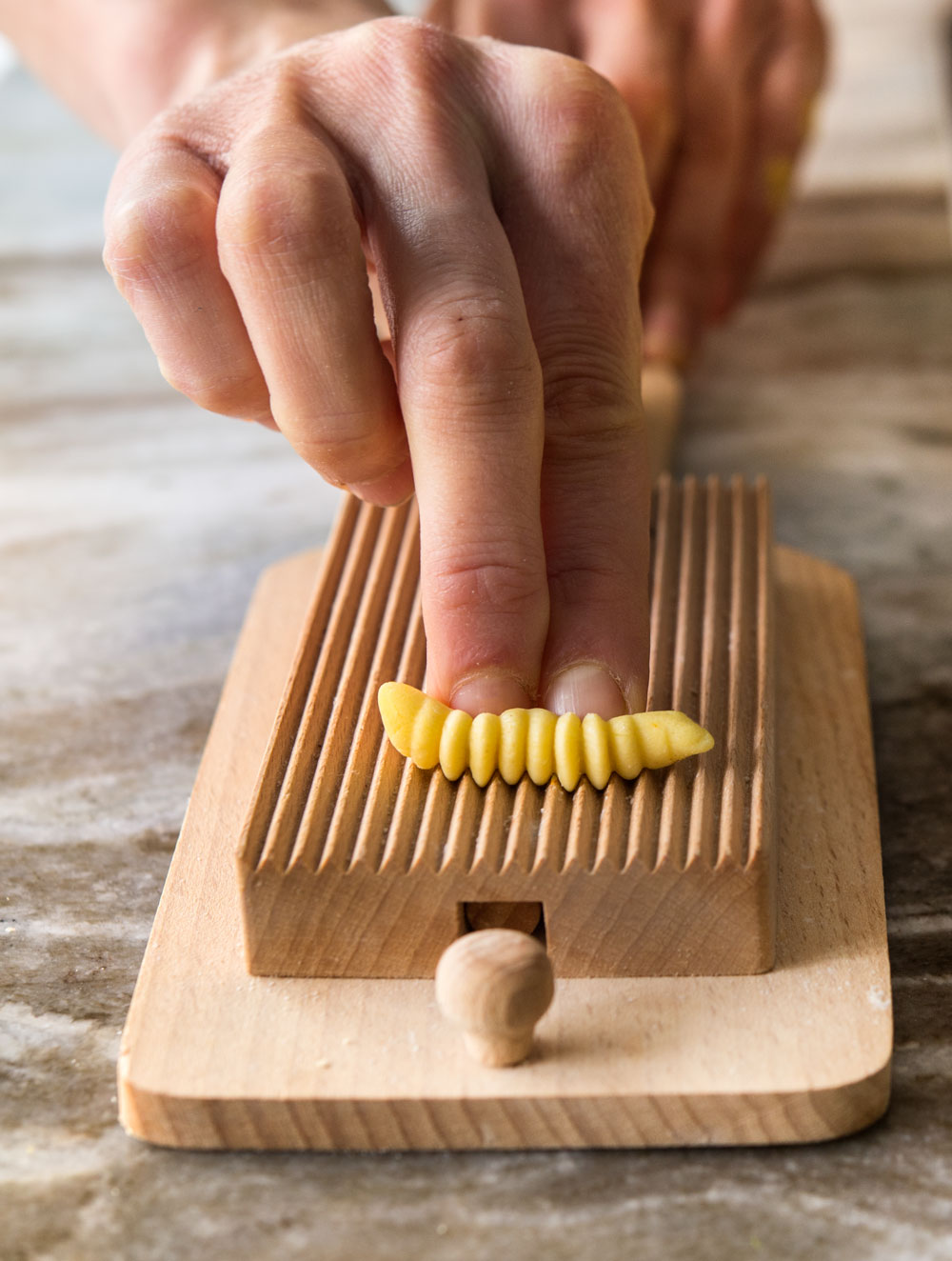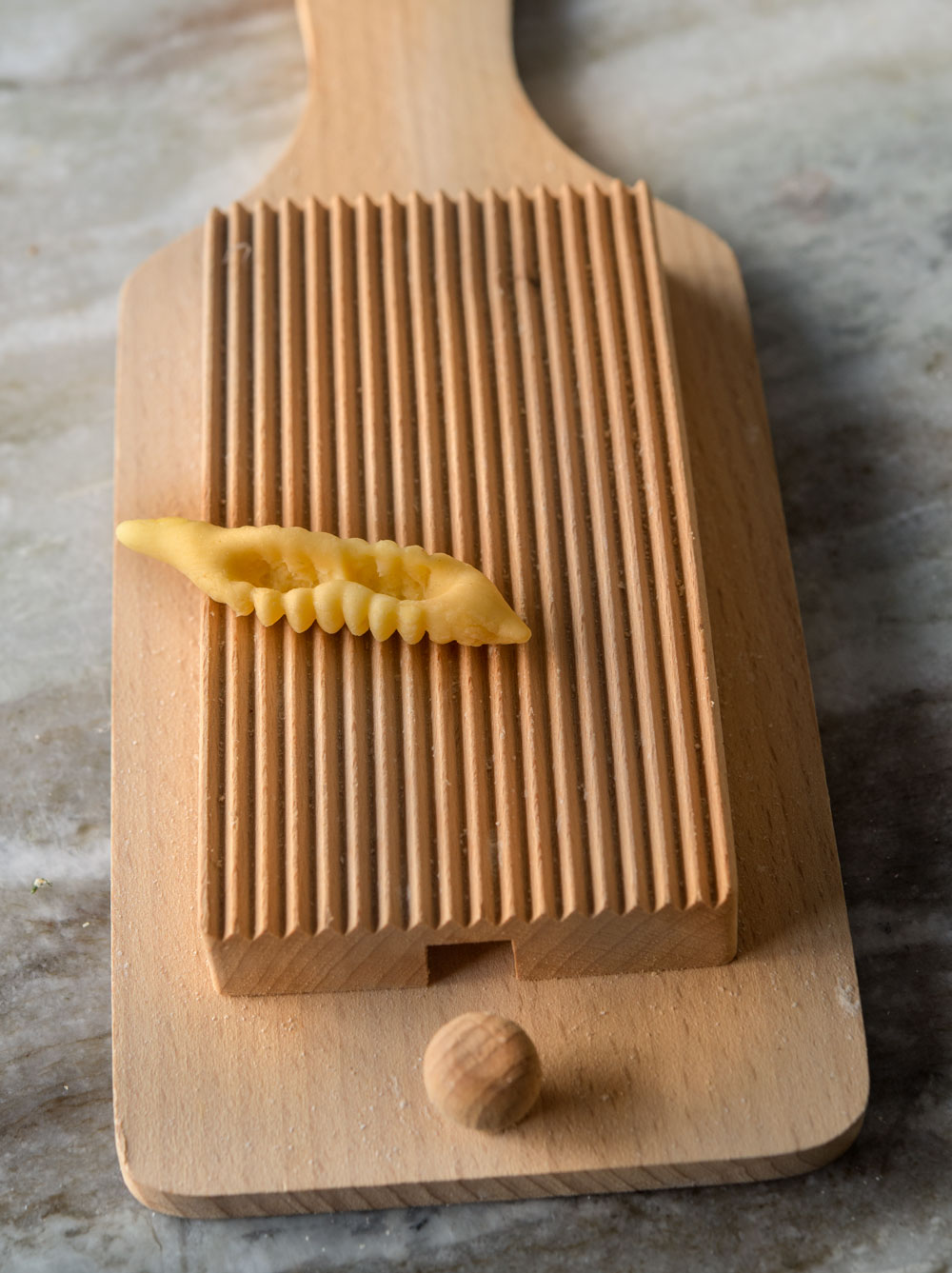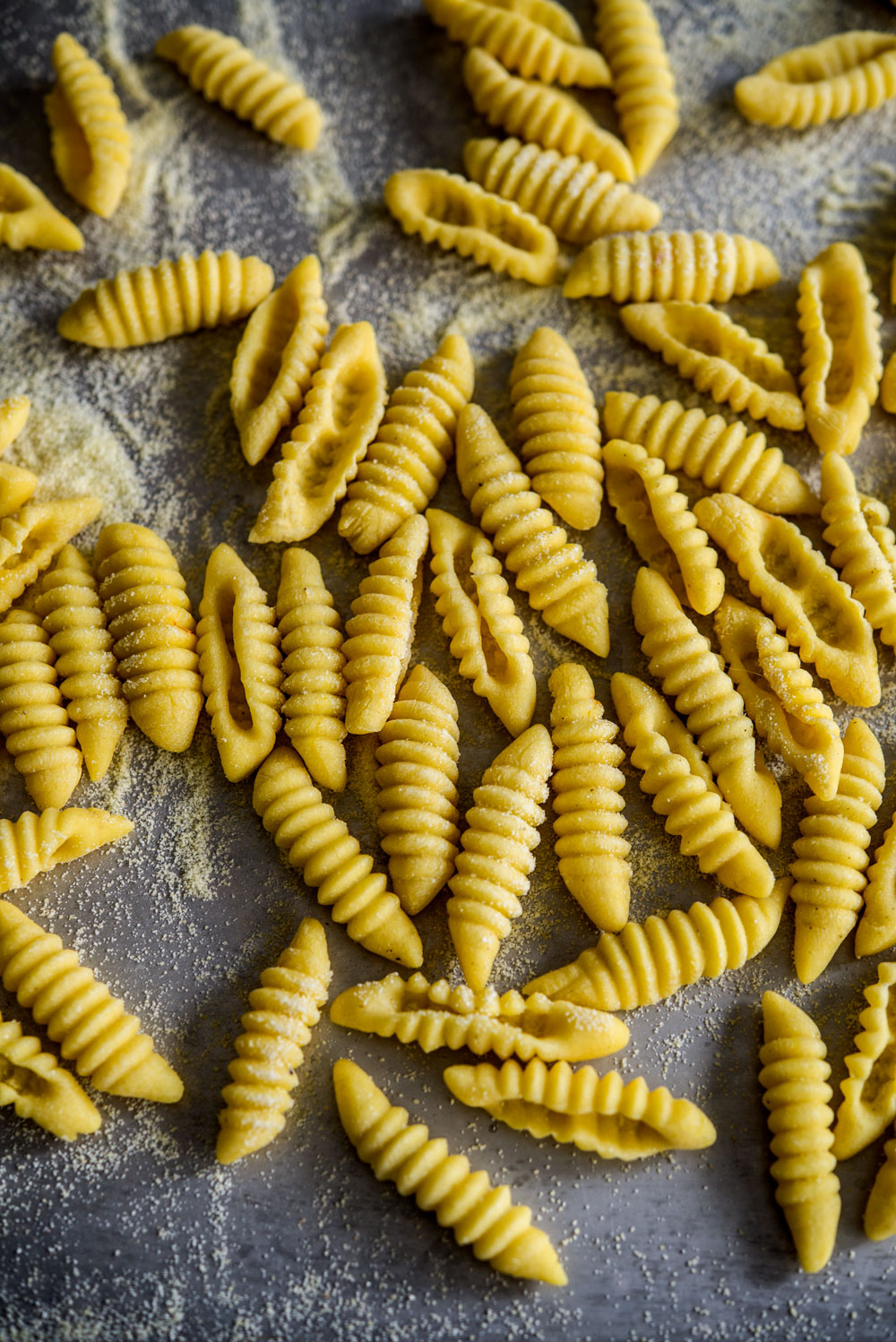I love pasta. I love eating pasta. I love making pasta. I love rolling out pasta by hand; I find it therapeutic.
In fact, a couple years back, I did a one-week pasta class with a former chef from Flour + Water while at the Dublin Cookery School in Ireland. It was such a fun week and really upped my pasta-making game.
Making pasta can be a time-consuming process. However, this pasta shape is actually quite approachable. It does not require any special pasta equipment, such as a hand-cranked pasta machine or even a rolling pin.
At its most basic, pasta is merely flour and water. Depending on the type of pasta and its region of origin, eggs are sometimes added. Eggs add richness and color to pasta. Sometimes, olive oil, salt, and/or other ingredients (e.g., squid ink, beets, spinach) are added.
According to Italy Magazine, it is estimated that there are 350 pasta shapes and at least four times as many names for them. This pasta, which I’m calling cavatelli, requires just semolina flour, durum wheat flour, water (and saffron, for color, if you like).
First off, let’s explore the difference between semolina and durum. Actually, let’s step back a bit and explore what a whole grain (kernel) is. A whole grain is comprised of three edible parts:
1) the outer bran (~14.5% of kernel weight; the multi-layered outer skin, mostly fiber);
2) the middle endosperm (~83% of kernel weight; the germ’s food supply, containing starchy carbohydrates, proteins, and small amounts of vitamins and minerals; where semolina flour, durum flour, and white flour come from);
3) the inner germ (~ 2.5% of kernel weight; the embryo or sprouting section; the small nutrient-rich core of the kernel – all protected by an inedible husk)
A whole grain contains all three parts of the kernel.
Semolina and durum flour are made from milled durum wheat. Semolina and durum flour come from the endosperm of durum wheat. Semolina is separated from the rest of the grain during sifting and ground into a coarse yellow flour. Durum flour is durum wheat milled into a softer, finer flour. Semolina and durum flour have a high protein content, which is responsible for their pleasantly toothsome, chewy texture when cooked and makes them ideal for making pasta.
Perhaps more information than you were looking for?
Below are step-by-step pasta making instructions (that’s what you really wanted to know, right?).
First off, mix the flours (semolina and durum wheat) and make a well in the middle (I like to use a measuring cup for that)…


Dissolve a pinch of saffron threads in warm water and let sit for 15 minutes until it develops a bright yellow color. Slowly add the water to the well, straining out the saffron threads (the saffron adds color not flavor, so you could easily omit)…

With a fork, slowly begin to incorporate the flour into the water…



Once the dough comes together, knead by hand until smooth and elastic. Wrap in plastic and let rest at room temperature for 20 minutes. During this time, the flour will slowly absorb the water and become more hydrated…

Cut off a piece of dough (be sure to keep the rest covered in plastic so it doesn’t dry out) and roll out the piece to form a long rope, about 1/2-inch wide…

Cut into approximately 1/2-inch pieces…

Roll out a piece of dough between the palms of your hands until it looks like a peapod…

Place the piece of dough on the gnocchi board (or another type of textured surface, even an inexpensive bamboo sushi rolling mat works). With your index and middle finger, slowly roll the dough toward you…



Repeat and voilà…

Now the fun part, let’s make dinner — saffron pasta with clams and sausage…


Saffron Pasta
Adapted from Chef Steps
170 grams durum flour
170 grams semolina flour
175 grams warm water
pinch of saffron threads
Mix the durum and semolina flours together into a mound. Using the bottom of bowl or cup, create a small well in the middle.
Add saffron threads to the water. Stir until the water takes on a yellow color. Let sit for 15 minutes. With a fine-mesh sieve, strain the saffron water into the well.
With a fork, slowly incorporate the flour into the liquid, little by little. When the dough comes together, use your hands to knead the dough until springy and elastic. Continue to rotate the dough while kneading it to work different angles. Wrap the dough with plastic and let it rest for 20 minutes at room temperature.
Cut off a portion of the pasta dough (making sure to keep the rest covered with plastic wrap so it doesn’t dry out). On a clean work surface, roll the portion into a rope until it’s about 1/2-inch thick.
Slice the dough into sections roughly 1/2-inch long pieces. Then, using the palm of your hands, roll them until they look like pea pods. Place the piece of dough on a gnocchi board (or another type of textured surface, even an inexpensive bamboo sushi rolling mat works), and with your index and middle finger, slowly roll the dough toward you. Repeat the process with the remaining dough.
Drop the pasta into a pot of salted water and cook until they float to the top and are al dente, about 2 to 3 minutes. Or, you can let dry at room temperature and then freeze.
Saffron Pasta with Clams and Sausage
For the clams:
1 tablespoon olive oil
1 large shallot, minced
1 1/2 cups dry white wine
2 dozen manila clams
To finish the dish:
1 tablespoon olive oil
6 to 8 ounces pork or lamb sausage, casing removed, broken into small pieces
3 cloves of garlic, thinly sliced
red chile flakes
1/3 cup dry white wine
3/4 cup chicken stock
1 tablespoon chopped parsley
Grated lemon zest and lemon wedges for serving
To steam the clams:
Heat a large skillet over medium-high heat. Add the oil and shallot and cook until soft and translucent, about 3 minutes. Add the white wine and clams, cover, and cook until the clams open, about 3 to 4 minutes. As the clams pop open, remove them from the pot and place in a bowl. Discard any clams that do not open. Continue to cook the liquid until it’s reduced by half. Pour the liquid over the reserved clams.
To finish the dish:
Bring a large pot of salted water to a boil.
In a large skillet over medium-high heat add the olive oil and pieces of sausage. Brown the sausage on all sides, about 3 minutes. Add the garlic and a large pinch of chile flakes and continue to cook until the garlic is soft but not browned, 2 to 3 minutes. Add the wine and cook until almost evaporated, about 30 seconds. Add the chicken stock and bring to a simmer. Drop the pasta into the boiling water. Cook the pasta until about 80% cooked through, 2 to 3 minutes. With a slotted spoon transfer the pasta to the skillet, reserving some of the pasta water. Add the clams to the skillet and stir to combine. Add a bit of the reserved pasta water. Continue to cook another minute or two until warmed through. Add the chopped parsley and lemon zest. Serve with lemon wedges.







